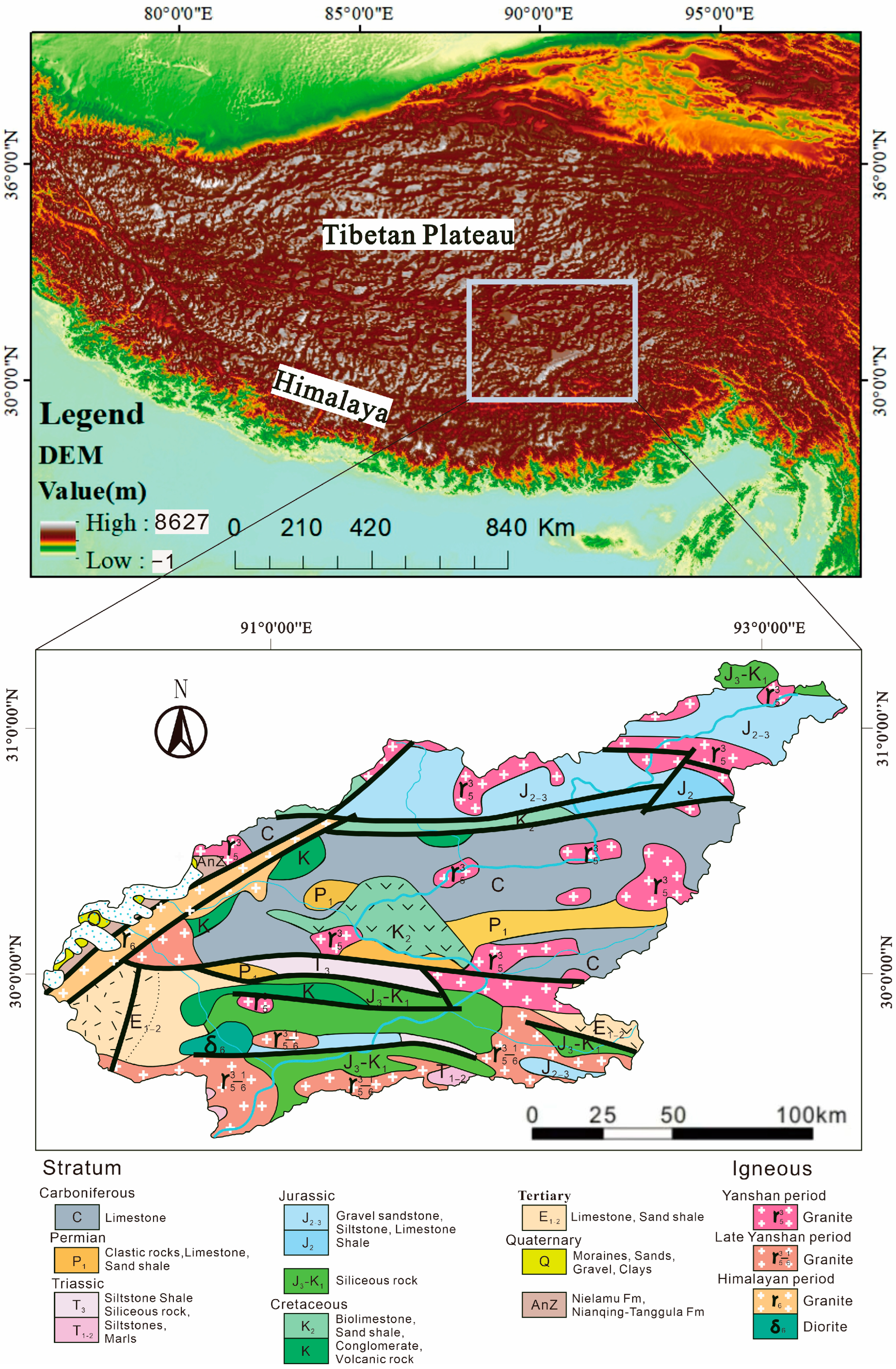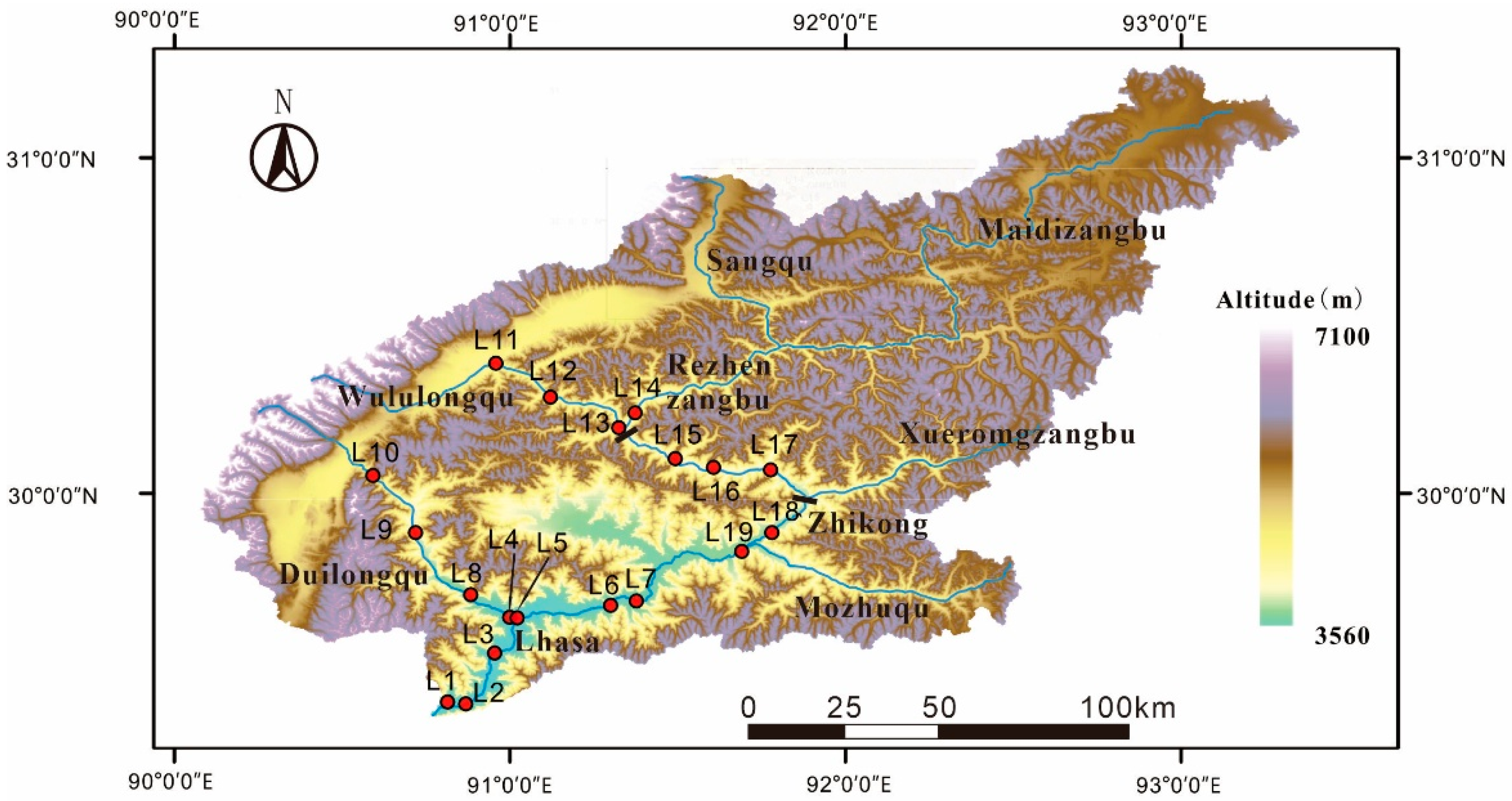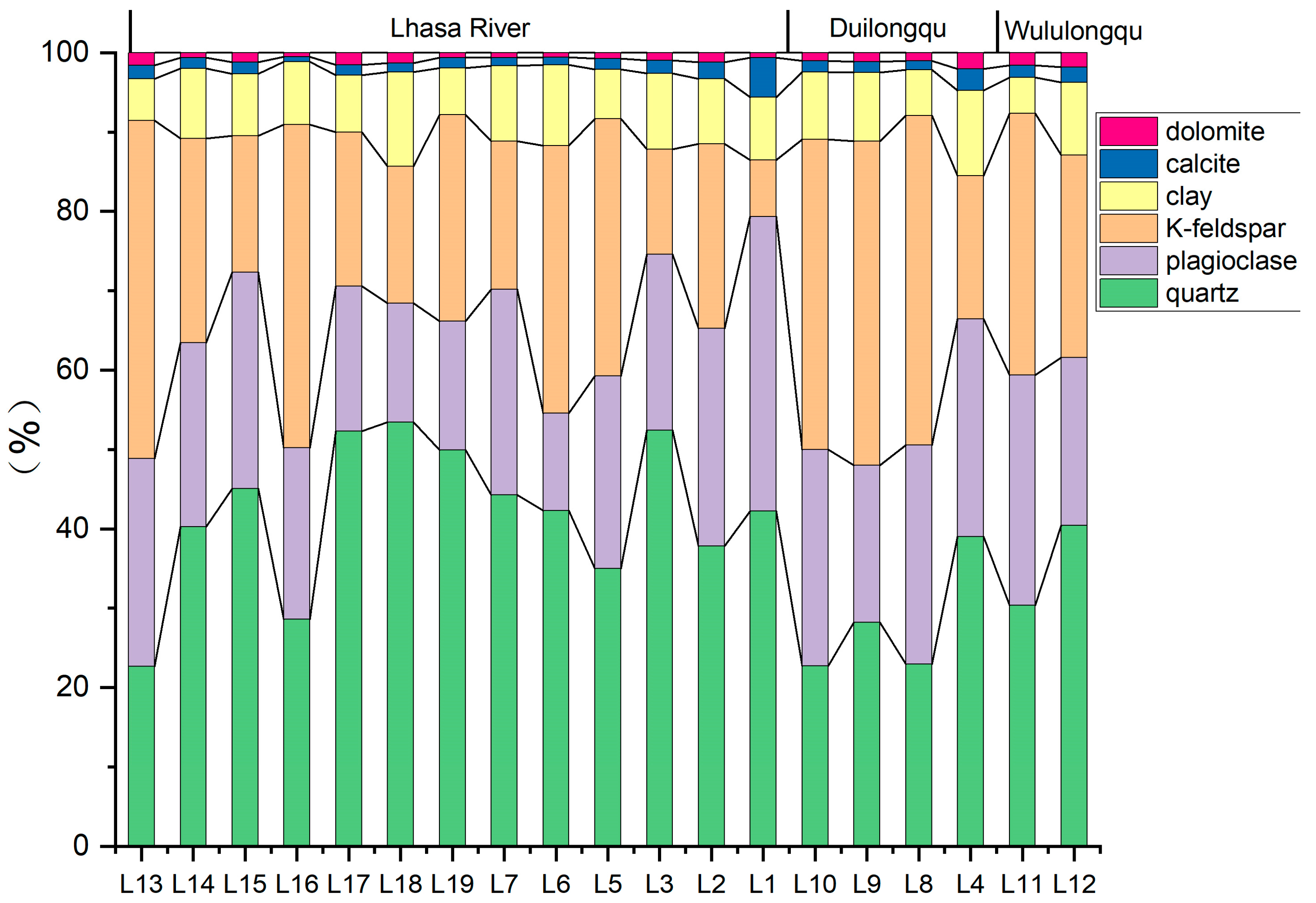Mineralogical and Chemical Characteristics of Sediments in the Lhasa River Basin: Implications for Weathering and Sediment Transport
Abstract
1. Introduction
2. Materials and Methods
2.1. Study Area
2.2. Sample Collection
2.3. Grain Size Analysis
2.4. Mineral Analysis
2.5. Major Elements Analysis
3. Results
3.1. Grain Size Composition
3.2. Mineral Composition
3.2.1. Mineralogy
3.2.2. Clay Mineral Composition
3.2.3. Major-Element Compositions
4. Discussion
4.1. Sedimentary Characteristics of the Lhasa River
4.2. Weathering Characteristics and Influencing Factors
4.3. Weathering Control on Clay Mineral
5. Conclusions
- (1)
- The average grain size of the Lhasa River sediments is coarse, dominated by sand, followed by silt, with low clay content and a small amount of gravel. Sediment sorting is poor, with mostly positive skewness and wide kurtosis. The content of silt and clay in the lower reaches of the Lhasa River is higher than that in the middle reaches, and the hydrodynamic conditions are weaker. The hydrodynamic conditions in the middle reaches are stronger than those in the lower reaches due to the influence of topographic changes.
- (2)
- Quartz and feldspar are the dominant minerals in the Lhasa River sediments, of which the quartz content is the highest (38.4% on average), followed by potassium feldspar (27.11%) and plagioclase feldspar (23.64%), and clay minerals and carbonate minerals being less abundant. The Lhasa River sediments show low to moderate maturity, which correlates with weathering and denudation of sand shale, moderately acidic volcaniclastic clasts, and magmatic rocks that are widespread in the watershed.
- (3)
- The Lhasa River has low CIA values, ranging from 49.03 to 62.66, indicating a low degree of chemical weathering. Weathering in the Lhasa River basin is influenced by the dry and cold climate, and the large exposure of granite with strong physical weathering also contributes to the low chemical weathering in the basin.
- (4)
- The Lhasa River sediments have the highest content of the clay mineral illite (83.3% on average), slightly higher chlorite content than kaolinite, and very low smectite content.
Author Contributions
Funding
Data Availability Statement
Acknowledgments
Conflicts of Interest
References
- Ruddiman, W.F. (Ed.) Tectonic Uplift and Climatic Change; Plenum Press: New York, NY, USA, 1997; pp. 1–535. [Google Scholar]
- Wang, E.; Chen, L.; Chen, Z. Tectonic and climatic element-contrlled evolution of the Yalungzangbu River in southern tibet. Quat. Sci. 2002, 22, 365–373. [Google Scholar]
- Clift, P.D. Controls on the erosion of Cenozoic Asia and the flux of clastic sediment to the ocean. Earth Planet. Sci. Lett. 2006, 241, 571–580. [Google Scholar] [CrossRef]
- Ferraro, A.; Siciliano, A.; Spampinato, M.; Morello, R.; Trancone, G.; Race, M.; Guida, M.; Fabbricino, M.; Spasiano, D.; Fratino, U. A multi-disciplinary approach based on chemical characterization of foreshore sediments, ecotoxicity assessment and statistical analyses for environmental monitoring of marine-coastal areas. Mar. Environ. Res. 2024, 202, 106780. [Google Scholar] [CrossRef] [PubMed]
- Whipple, K.X. Bedrock rivers and the geomorphology of active orogens. Annu. Rev. Earth Planet. Sci. 2004, 32, 151–185. [Google Scholar] [CrossRef]
- Borges, J.B.; Huh, Y.; Moon, S.; Noh, H. Provenance and weathering control on river bed sediments of the eastern Tibetan Plateau and the Russian Far East. Chem. Geol. 2008, 254, 52–72. [Google Scholar] [CrossRef]
- Clift, P.D.; Hodges, K.V.; Heslop, D.; Hannigan, R.; Van Long, H.; Calves, G. Correlation of himalayan exhumation rates and asian monsoon intensity. Nat. Geosci. 2008, 1, 875–880. [Google Scholar] [CrossRef]
- van der Beek, P.; Litty, C.; Baudin, M.; Mercier, J.; Robert, X.; Hardwick, E. Contrasting tectonically driven exhumation and incision patterns, western versus central Nepal Himalaya. Geology 2016, 44, 327–330. [Google Scholar] [CrossRef]
- Hren, M.T.; Chamberlain, C.P.; Hilley, G.E.; Blisniuk, P.M.; Bookhagen, B. Major ion chemistry of the Yarlung Tsangpo–Brahmaputra river: Chemical weathering, erosion, and CO2 consumption in the southern Tibetan plateau and eastern syntaxis of the Himalaya. Geochim. Et. Cosmochim. Acta 2007, 71, 2907–2935. [Google Scholar] [CrossRef]
- Kumar, S.; Luo, C.; Rahman, A.; Thilakanayaka, V.; Khan, H.R.; Liu, J.; Islam, G.A. Modern alluvial pollen distribution in Ganges–Brahmaputra–Meghna (GBM) floodplain and its paleoenvironmental significance. Rev. Palaeobot. Palynol. 2019, 267, 1–16. [Google Scholar] [CrossRef]
- Yu, Z.; Yan, N.; Wu, G.; Xu, T.; Li, F. Chemical weathering in the upstream and midstream reaches of the Yarlung Tsangpo basin, southern Tibetan Plateau. Chem. Geol. 2021, 559, 119906. [Google Scholar] [CrossRef]
- Leeder, M.R. Tectonic sedimentology: Sediment systems deciphering global to local tectonics. Sedimentology 2011, 58, 2–56. [Google Scholar] [CrossRef]
- Zhang, W.; Wu, J.; Zhan, S.; Pan, B.; Cai, Y. Environmental geochemical characteristics and the provenance of sediments in the catchment of lower reach of Yarlung Tsangpo River, southeast Tibetan Plateau. Catena 2021, 200, 105150. [Google Scholar] [CrossRef]
- Li, C.; Kang, S.; Zhang, Q.; Wang, F. Rare earth elements in the surface sediments of the Yarlung Tsangbo (Upper Brahmaputra River) sediments, southern Tibetan Plateau. Quat. Int. 2009, 208, 151–157. [Google Scholar] [CrossRef]
- Hasan, A.M.; Hossain, I.; Rahman, M.A.; Pownceby, M.I.; Biswas, P.K.; Zaman, M.N. Signature of Himalayan orogenic features in Brahmaputra River sediments, Bangladesh: Evidence from single-grain heavy mineral chemistry. Geochemistry 2022, 82, 125897. [Google Scholar] [CrossRef]
- Su, F.; Zhang, L.; Ou, T.; Chen, D.; Yao, T.; Tong, K.; Qi, Y. Hydrological response to future climate changes for the major upstream river basins in the Tibetan Plateau. Glob. Planet. Change 2016, 136, 82–95. [Google Scholar] [CrossRef]
- Cuo, L.; Zhang, Y.; Zhu, F.; Liang, L. Characteristics and changes of streamflow on the Tibetan Plateau: A review. J. Hydrol. Reg. Stud. 2014, 2, 49–68. [Google Scholar] [CrossRef]
- Zhang, J.; Xu, J.; Tan, X.; Zhang, Q. Nitrogen loadings affect trophic structure in stream food webs on the Tibetan Plateau, China. Sci. Total Environ. 2022, 844, 157018. [Google Scholar] [CrossRef]
- Ning, A.; Liu, T.; Yin, G.; Liu, F. Study on the water environment and composition of Lhasa River. Sci. China Ser. E Technol. Sci. 2001, 44, 96–100. [Google Scholar] [CrossRef]
- Li, M.; Sun, X.; Li, S.; Wang, J.; Lu, Z.; Zhang, Q. Hydrochemistry dynamics in a glacierized headwater catchment of Lhasa River, Tibetan Plateau. Sci. Total Environ. 2024, 919, 170810. [Google Scholar]
- Mao, G.; Duan, X.; Niu, Z.; Xu, J.; Xiao, X.; Huang, X.; Chen, H.; Mehr, F.; Moti, R.; Qiao, Z. Application of source sink theory and MCR model to assess hydrochemical change risk in Lhasa River basin, Tibet, China. Environ. Impact Assess. Rev. 2023, 101, 107124. [Google Scholar] [CrossRef]
- Folk, R.L.; Ward, W.C. Brazos River Bar: A Study in the Significance of Grain Size Parameters. J. Sediment. Res. 1957, 27, 3–26. [Google Scholar] [CrossRef]
- Biscaye, P.E. Mineralogy and sedimentation of recent deep-sea clay in the Atlantic Ocean and adjacent seas and oceans. Geol. Soc. Am. Bull. 1965, 76, 803–832. [Google Scholar] [CrossRef]
- Mao, C.; Chen, J.; Yuan, X.; Yang, Z.; Balsam, W.; Ji, J. Seasonal variation in the mineralogy of the suspended particulate matter of the lower Changjiang river at Nanjing, China. Clays Clay Miner. 2010, 58, 691–706. [Google Scholar] [CrossRef]
- Roux JP, L.; Rojas, E.M. Sediment transport patterns determined from grain size parameters: Overview and state of the art. Sediment. Geol. 2007, 202, 473–488. [Google Scholar] [CrossRef]
- Roddaz, M.; Viers, J.; Brusset, S.; Baby, P.; Boucayrand, C.; Hérail, G. Controls on weathering and provenance in the Amazonian foreland basin: Insights from major and trace element geochemistry of Neogene Amazonian sediments. Chem. Geol. 2006, 226, 31–65. [Google Scholar] [CrossRef]
- Taylor, S.R.; Mclennan, S.M. The continental crust: Its composition and evolution. J. Geol. 1985, 94, 57–72. [Google Scholar]
- Yang, S.L. Sedimentation on a growing intertidal island in the Yangtze River mouth. Estuar. Coast. Shelf Sci. 1999, 49, 401–410. [Google Scholar] [CrossRef]
- Potter, P. Petrology and Chemistry of Modern Big River Sands. J. Geol. 1978, 86, 423–449. [Google Scholar] [CrossRef]
- Zhang, K.-J.; Xia, B.-D.; Wang, G.-M.; Li, Y.-T.; Ye, H.-F. Early Cretaceous stratigraphy, depositional environments, sandstone provenance, and tectonic setting of central Tibet, western China. Geol. Soc. Am. Bull. 2004, 116, 1202. [Google Scholar] [CrossRef]
- Herron, M.M. Geochemical classification of terrigenous sands and shales from core or log data. J. Sediment. Res. 1988, 58, 820–829. [Google Scholar]
- Wu, W.; Zheng, H.; Xu, S.; Yang, J.; Yin, H. Geochemistry and provenance of bed sediments of the large rivers in the Tibetan Plateau and Himalayan region. Int. J. Earth Sci. 2012, 101, 1357–1370. [Google Scholar] [CrossRef]
- Hossain, H.M.Z. Major, trace, and REE geochemistry of the Meghna River sediments, Bangladesh: Constraints on weathering and provenance. Geol. J. 2020, 55, 3321–3343. [Google Scholar] [CrossRef]
- Huyan, Y.Y.; Yao, W.S. Geochemical comparisons of weathering, provenance and tectonics in the fluvial sediments from Yarlung Zangbo to Brahmaputra River. Catena 2022, 210, 105944. [Google Scholar] [CrossRef]
- Gao, Y.; Yang, Z.; Hou, Z.; Wei, R.; Meng, X.; Tian, S. Eocene potassic and ultrapotassic volcanism in south Tibet: New constraints on mantle source characteristics and geodynamic processes. Lithos 2010, 117, 20–32. [Google Scholar] [CrossRef]
- Yang, S.; Jung, H.-S.; Li, C. Two unique weathering regimes in the Changjiang and Huanghe drainage basins: Geochemical evidence from river sediments. Sediment. Geol. 2004, 164, 19–34. [Google Scholar] [CrossRef]
- Nesbitt, H.W.; Young, G.M. Early Proterozoic climates and plate motions inferred from major element chemistry of lutites. Nature 1982, 299, 715–717. [Google Scholar] [CrossRef]
- Nesbitt, H.W.; Fedo, C.M.; Young, G.M. Quartz and feldspar stability, steady and non-steady state weathering and petrogenesis of siliciclastic sands and muds. J. Geol. 1997, 105, 173–191. [Google Scholar] [CrossRef]
- Galy, A.; France-Lanord, C. Higher erosion rates in the Himalaya: Geochemical constraints on riverine fluxes. Geology 2001, 29, 23–26. [Google Scholar] [CrossRef]
- Chang, H.Q.; Fu, Y.L.; Lin, X.; Zhang, M.; Meng, G. Spatial distribution and controlling factors of chemical weathering intensity in drainage basins: A case study in the Yangtze River Basin and Pearl River Basin. Adv. Earth Sci. 2019, 34, 93–102. (In Chinese) [Google Scholar]
- Li, Y.; Clift, P.D.; Murray, R.W.; Exnicios, E.; Ireland, T.; Böning, P. Asian summer monsoon influence on chemical weathering and sediment provenance determined by clay mineral analysis from the Indus Submarine Canyon. Quat. Res. 2019, 93, 23–39. [Google Scholar] [CrossRef]
- Liu, Z.; Colin, C.; Huang, W.; Le, K.P.; Tong, S.; Chen, Z.; Trentesaux, A. Climatic and tectonic controls on weathering in South China and Indochina Peninsu-la: Clay mineralogical and geochemical investigations from the Pearl, Red, and Mekong drainage basins. Geochemistry. Geophys. Geosystems 2007, 8, Q05005. [Google Scholar]
- Segall, M.P.; Kuehl, S.A. Sedimentary processes on the Bengal continental shelf as revealed by clay-size mineralogy. Cont. Shelf Res. 1992, 12, 517–541. [Google Scholar] [CrossRef]
- David, C.H.; Steven, A.K.; Steven, L.G. Mineralogy of the Ganges and Brahmaputra Rivers: Implications for river switching and Late Quaternary climate change. Sediment. Geol. 2003, 155, 343–359. [Google Scholar]
- Yang, Z.S. Mineralogical assemblages and chemical characteristics of clays from sediments of the Huanghe, Changjiang, Zhujiang Rivers and their relationship to the climate environment in their sediment source areas. Oceanol. Et. Limnol. Sin. 1988, 19, 336–346. (In Chinese) [Google Scholar]
- He, M.; Zheng, H.; Huang, X.; Jia, J.; Li, L. Yangtze River sediments from source to sink traced with clay mineralogy. J. Asian Earth Sci. 2013, 69, 60–69. [Google Scholar] [CrossRef]
- Khan, M.H.R.; Liu, J.; Liu, S.; Cao, L.; Rehman, A.; Seddique, A.A. Clay mineral compositions in surface sediments of the Ganges-Brahmaputra-Meghna river system of Bengal Basin, Bangladesh. Mar. Geol. 2019, 412, 27–36. [Google Scholar] [CrossRef]










| Sample Type | Gravel (%) | Sand (%) | Silt (%) | Clay (%) | |
| Max | 81.51 | 99.62 | 59.91 | 10.97 | |
| Mean | 7.00 | 65.45 | 23.64 | 3.91 | |
| Min | 0.00 | 17.79 | 0.00 | 0.00 | |
| Grain size parameters | Mean grain size (Φ) | Sorting coefficient (δ) | Skewness (SK) | Kurtosis (KG) | |
| Max | 5.29 | 2.99 | 0.60 | 3.70 | |
| Mean | 2.84 | 1.64 | 0.27 | 1.35 | |
| Min | −1.17 | 0.50 | −0.11 | 0.80 |
| Sample | AL2O3 | CaO | Fe2O3 | K2O | MgO | MnO | Na2O | P2O5 | SiO2 | TiO2 | Al2O3/SiO2 | CIA |
|---|---|---|---|---|---|---|---|---|---|---|---|---|
| L1 | 15.52 | 1.25 | 4.34 | 3.37 | 1.63 | 0.06 | 2.02 | 0.14 | 66.63 | 0.64 | 4.3 | 62.66 |
| L2 | 13.68 | 1.68 | 3.52 | 3.46 | 1.10 | 0.06 | 2.95 | 0.16 | 70.27 | 0.59 | 5.1 | 53.94 |
| L3 | 10.91 | 1.27 | 2.89 | 3.12 | 1.03 | 0.06 | 2.27 | 0.08 | 76.45 | 0.45 | 7.0 | 53.64 |
| L4 | 14.26 | 1.69 | 3.34 | 3.78 | 1.31 | 0.06 | 2.86 | 0.05 | 70.82 | 0.50 | 5.0 | 54.57 |
| L5 | 13.21 | 1.80 | 2.72 | 3.48 | 0.81 | 0.05 | 3.16 | 0.15 | 72.61 | 0.50 | 5.4 | 51.86 |
| L6 | 13.14 | 1.28 | 3.61 | 3.23 | 1.19 | 0.05 | 2.01 | 0.13 | 71.62 | 0.56 | 5.4 | 58.96 |
| L7 | 13.54 | 1.34 | 5.61 | 2.89 | 1.42 | 0.10 | 1.80 | 0.12 | 70.13 | 0.74 | 5.2 | 61.33 |
| L8 | 14.57 | 1.52 | 2.89 | 3.80 | 0.79 | 0.05 | 3.40 | 0.09 | 70.52 | 0.41 | 4.9 | 53.86 |
| L9 | 13.36 | 1.83 | 2.78 | 3.72 | 1.04 | 0.05 | 3.22 | 0.11 | 72.15 | 0.42 | 5.4 | 51.32 |
| L10 | 13.96 | 2.11 | 3.25 | 4.12 | 0.75 | 0.09 | 3.77 | 0.26 | 70.17 | 0.58 | 5.0 | 49.03 |
| L11 | 13.89 | 2.24 | 2.29 | 4.24 | 0.62 | 0.05 | 3.46 | 0.10 | 71.91 | 0.32 | 5.1 | 49.16 |
| L12 | 14.21 | 2.18 | 3.26 | 3.69 | 0.96 | 0.07 | 2.87 | 0.20 | 70.80 | 0.51 | 5.0 | 52.81 |
| L13 | 17.96 | 2.14 | 4.24 | 4.24 | 1.84 | 0.11 | 3.75 | 0.12 | 63.00 | 0.61 | 3.5 | 55.04 |
| L14 | 13.50 | 1.07 | 3.91 | 3.89 | 1.21 | 0.06 | 1.86 | 0.09 | 72.03 | 0.57 | 5.3 | 59.38 |
| L15 | 16.45 | 1.18 | 8.05 | 5.33 | 1.92 | 0.11 | 2.51 | 0.08 | 61.83 | 0.70 | 3.7 | 57.70 |
| L16 | 12.86 | 1.21 | 3.41 | 3.66 | 0.98 | 0.06 | 1.96 | 0.09 | 73.00 | 0.55 | 5.7 | 57.79 |
| L17 | 12.69 | 0.75 | 3.83 | 3.75 | 1.11 | 0.06 | 2.01 | 0.06 | 73.72 | 0.43 | 5.8 | 59.22 |
| L18 | 13.18 | 1.36 | 5.92 | 3.02 | 2.33 | 0.29 | 2.40 | 0.07 | 68.94 | 0.56 | 5.2 | 57.58 |
| L19 | 13.01 | 0.92 | 5.28 | 3.29 | 1.54 | 0.08 | 2.24 | 0.05 | 71.32 | 0.58 | 5.5 | 59.30 |
| mean | 13.81 | 1.73 | 3.63 | 3.71 | 1.17 | 0.09 | 3.03 | 0.12 | 70.8 | 0.48 | 5.1 | 62.70 |
| UCC | 15.4 | 3.59 | 5.04 | 2.80 | 2.48 | 0.10 | 3.27 | 0.15 | 66.6 | 0.64 |
Disclaimer/Publisher’s Note: The statements, opinions and data contained in all publications are solely those of the individual author(s) and contributor(s) and not of MDPI and/or the editor(s). MDPI and/or the editor(s) disclaim responsibility for any injury to people or property resulting from any ideas, methods, instructions or products referred to in the content. |
© 2025 by the authors. Licensee MDPI, Basel, Switzerland. This article is an open access article distributed under the terms and conditions of the Creative Commons Attribution (CC BY) license (https://creativecommons.org/licenses/by/4.0/).
Share and Cite
Zhang, H.; Li, T.; Mao, C.; Song, Z.; Rao, W. Mineralogical and Chemical Characteristics of Sediments in the Lhasa River Basin: Implications for Weathering and Sediment Transport. Water 2025, 17, 581. https://doi.org/10.3390/w17040581
Zhang H, Li T, Mao C, Song Z, Rao W. Mineralogical and Chemical Characteristics of Sediments in the Lhasa River Basin: Implications for Weathering and Sediment Transport. Water. 2025; 17(4):581. https://doi.org/10.3390/w17040581
Chicago/Turabian StyleZhang, Heyulu, Tianning Li, Changping Mao, Zhengjin Song, and Wenbo Rao. 2025. "Mineralogical and Chemical Characteristics of Sediments in the Lhasa River Basin: Implications for Weathering and Sediment Transport" Water 17, no. 4: 581. https://doi.org/10.3390/w17040581
APA StyleZhang, H., Li, T., Mao, C., Song, Z., & Rao, W. (2025). Mineralogical and Chemical Characteristics of Sediments in the Lhasa River Basin: Implications for Weathering and Sediment Transport. Water, 17(4), 581. https://doi.org/10.3390/w17040581






